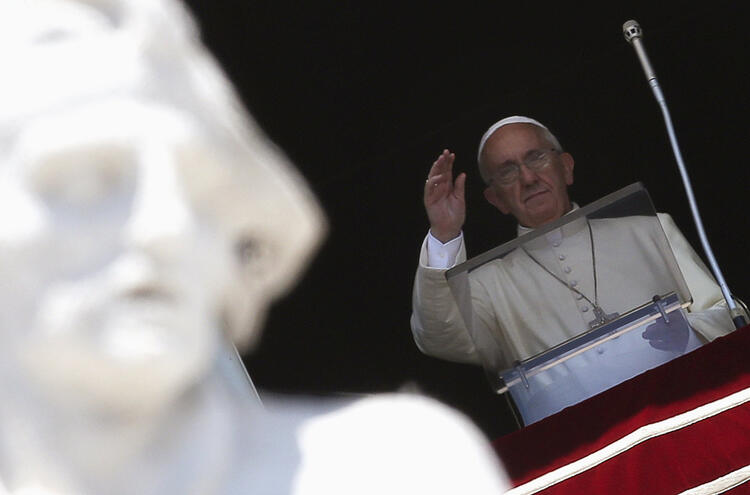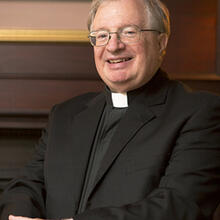Since the first days of his pontificate, Pope Francis has spoken of his plans to renew the Synod of Bishops. In the last weeks it emerged as a centerpiece of his ministry. Three times this month he has spoken of “synodality," that is, the role of meetings of bishops in church governance. The new pope suggests that synodality may be a source of unity within the Catholic Church itself as well as with the Orthodox, for whom synodality is the primary form of church governance.
Keep alert. Listen for this word, “synodality.” It looks to be the heart of the Franciscan reform of the church.
While the advance of collegiality among bishops is regarded as one of the great ambitions of the Second Vatican Council, it was an idea still born. A Nota Praevia, a preliminary note, attached to the Dogmatic Constitution on the Church, Lumen Gentium, by Pope Paul VI, directed that none of the document’s teaching on collegiality or the Synod of Bishops should prejudice the rights and privileges of the pope and the Holy See. As a result, the Synod of Bishops has been a consultative, not a deliberative body, and its effectiveness depends on papal endorsement.
The only teaching document ever issued directly by a Synod was “Justice in the World” in 1971. Ever since the results of subsequent synods have been published by the pope as apostolic exhortations, whose release marks the conclusion of the synod. Under Pope John Paul II the church became more centralized, the teaching power of bishops was curbed, and the workings of the Synod of Bishops tightly controlled.
From the beginning Pope Francis has indicated his desire for greater representation in the running of the church. The most concrete step he has taken in that direction was the appointment of a council of cardinals from each of the continents to advise him on church renewal and the reform of the Roman curia. He has also indicated the council may be replaced in the years ahead by a council elected by the Synod.
In mid-June, when he met with bishops planning the next meeting of the Synod of Bishops, he considered with them a number of topics including ecology, a topic close to his heart, as the focus for the next general assembly of the Synod in 2014. But the one topic that received special attention was (the strengthening of) the Synod itself and the wider theological concept of synodality, suggesting exploration of a real development in Catholic ecclesiology where various deliberative bodies might have an increased role in church governance.
Francis has already made clear, for example, he favors greater autonomy for bishops’ conferences, a move consistent with a more synodal ecclesiology. In one talk this month, he indicated that as it stood the Synod of Bishops was a still “half-baked” development of Vatican II. Not “half-baked” in the derogatory sense, I think, but rather in the sense of “unfinished” like “a work in progress.” The day for the Synod and other church bodies (diocesan councils, e.g.) to come into their own is drawing close. Canonists should get ready to do a lot of new work.
On Saturday, June 30, in his homily for conferral of the pallium on new archbishops, he told them, their task, like his, is to confirm the unity (in difference) of the church. “Let us go forward,” he urged in unscripted remarks, “on the path of synodality, and grow in harmony with the service of [papal] primacy.” In effect, Pope Francis has re-founded the pallium, traditionally a symbol of unity with the pope, as symbol of both collegiality and papal primacy.
Just as important was a statement Francis made during a meeting with a delegation of Orthodox bishops who had come to join the celebration for the feast of Saints Peter and Paul. He told them he hoped to learn from them about “Episcopal collegiality, and the tradition of synodality, so typical of the Orthodox churches.” For a millennium what distinguished the Roman Catholic Church from the synodal and regionally organized Orthodox Church had been the monarchical papacy and its centralized government.
Reform of the Synod of Bishops and the growth of synodality within the western Catholic Church would greatly enhance the opportunity for union between Rome and the Churches of the East, removing two of the greatest obstacles to reunion, the monarchical papacy and Roman centralism. The Eastern Catholic Churches already have some degree of synodality, though they have made it clear that they would prefer still greater autonomy from Rome.
Two things that drew the Ecumenical Patriarch Bartholomew to Rome at the time of Pope Francis’s inauguration was Francis's reference to himself as “bishop of Rome” rather than as pope and his description of “the church of Rome [presiding]” over the other churches “in love.” Day by day, event by event, one symbol at a time, Pope Francis seems determined to make all the churches, most of all our own, understand that the true nature of primacy is a love which allows the other to be other.








